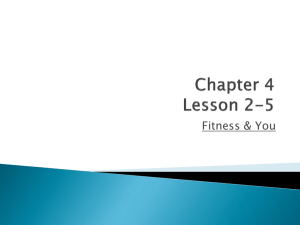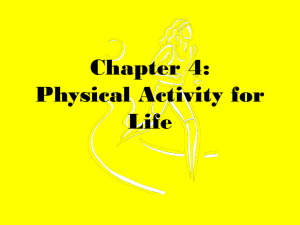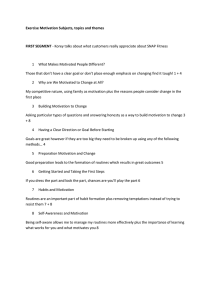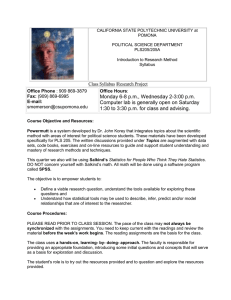Unit 2- Nutrition and Fitness
advertisement
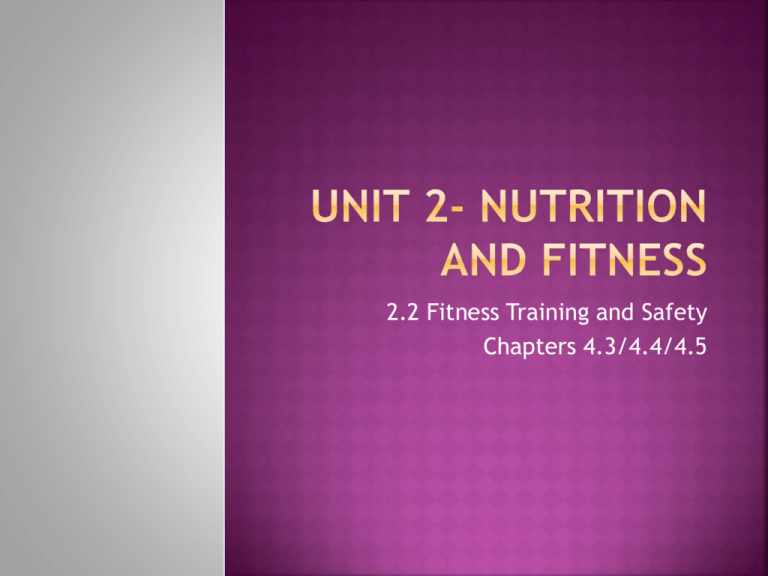
2.2 Fitness Training and Safety Chapters 4.3/4.4/4.5 Standard 2 Objective 2b: Develop strategies for maintaining life-long fitness and avoiding the consequences of inactivity. Objective 2d: Create individual fitness goals. Objective 2c: Identify and investigate available fitness resources Aerobic Exercise – Activities that are maintained for 10 or more minutes (running, jogging, biking, dancing). They require oxygen. Anaerobic Exercise – Activities that are done in short Bursts (weight training, 100 m dash). They do not require oxygen. Resting Heart Rate – The number of times your heart beats when you are inactive. Resting HR Max HR (220 – age) Resting HR Answer Answer Resting HR Target HR Range Overload – working the body harder than it is normally worked. Progression – the gradual increase in overload. Should be slightly difficult so your body has to adapt As your body adapts, the activity/exercise will become easier Specificity – particular exercises and activities to improve particular areas of fitness. Focusing on a specific area of the 5 Elements of Fitness and choosing activities that promote that type of fitness Warm-Up Workout Cool-Down Warm-Up – an activity that prepares the muscles for work. Should last about 5-10 minutes Describes many light-aerobic and cardiovascular activities Warming up the temperature of both your body and your muscles Can resemble the activity you are about to do but at a slower pace Workout – when the activity is performed at its peak. Frequency – how often. (3-5/week) Intensity – how hard. (Target HR Range) Time – how long. (30 min.) Type – what activity. (jogging, biking, swimming, etc.) Aerobic Anaerobic Cool-Down – an activity that prepares the muscles Benefits of cooling to return to a resting down: state. slow your heart rate Usually lasts 5-10 minutes to a normal speed return your breathing to its regular pace avoid stiffness and soreness of the muscles reduce any risk of dizziness and lightheadedness relaxes the muscles Frostbite HYPOTHERMIA INJURY SYMPTOMS TREATMENT Heat Exhaustion Cold clammy skin Lie down in a cool place with feet elevated. Sip cool water. Heat Cramps Muscle spasms Lie down in a cool place with feet elevated. Sip cool water. Heat Stroke Increase in body temp, difficulty breathing Get medical attention immediately, sponge with cold water until help arrives. Frostbite – body tissue becomes frozen. Whitening of skin around ears, face, fingers, toes, nose Get indoors, seek medical attention. Hypothermia – body temp becomes dangerously low. Disorientation, loss of motor control Get immediate medical attention, wrap up in warm blanket, sip warm liquids. Muscle Cramp – sudden tightening of muscle. Muscle tightens in area of the cramp Rest, Ice, Compression, Elevation Strain – damaged muscle or tendon. Pain in the area of the strain Rest, Ice, Compression, Elevation Sprain – injury to ligament around a joint. Pain, swelling, discoloration Rest, Ice, Compression, Elevation Hydration: Taking in fluids so the body functions properly. Benefits of being hydrated include: Being more alert and focused Reaction time is quicker (muscles respond better) Less likely to cramp Endurance is greater Can help prevent electrolyte imbalance Korey Stringer was born May 8, 1974 in Warren Ohio. A Minnesota Vikings offensive lineman, Korey first started his career at The Ohio State University in 1992. In 1995 Korey was a first round draft pick for the Minnesota Vikings in the 2000–2001 season. Korey earned pro-bowl honors as a right tackle. Sadly, in August of 2001 Korey Stringer died from exertional heat stroke after a preseason practice session. Korey’s wife, Kelci founded the Korey Stringer Institute in honor of her late husband. http://www.youtube.com/watch?v=KzerHU LhZ64&edufilter=NspQGORDVL1bXbjqgB71q w Use protective equipment Get adequate rest Prevent inflammation, stop if it hurts Proper clothing/shoes Fuel up on electrolytes Wear supportive equipment when necessary (i.e. compression shorts/sports bras/jock straps) To Prevent an Injury R-rest the injured area I-Ice (no more than 20 min. at a time) C-compression, wrap to prevent and control swelling E-elevate above your heart level S-support the injured area, bracing/crutches/sling After an Injury Most people fail to recognize the negative effects of steroids! Most of the effects are long-term and lead to more severe problems later in life. Supplements Remember that supplements (i.e. Creatine, Caffeine, etc.) are not regulated by the FDA or any other agency. This means supplement companies can LIE and MISLEAD about what is actually in their products. Most research does not include adolescence agegroups or the long-term effects the product might have on a growing/maturing body! Standard 2 Objective 2b: Develop strategies for maintaining life-long fitness and avoiding the consequences of inactivity. Objective 2d: Create individual fitness goals. Objective 2c: Identify and investigate available fitness resources Chapter 4 Review pg. 106-107 Do Exploring Health Terms #1-15 Do Recalling Facts #1-10
